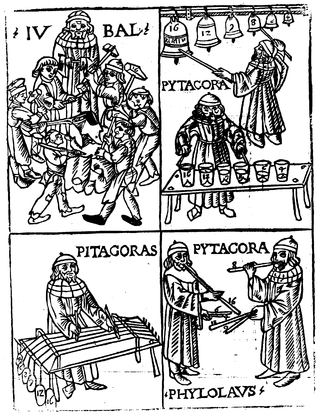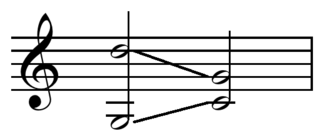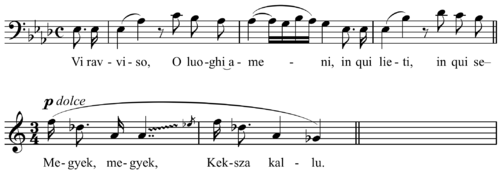In music, a glissando is a glide from one pitch to another. It is an Italianized musical term derived from the French glisser, "to glide". In some contexts, it is equivalent to portamento, which is a continuous, seamless glide between notes. In other contexts, it refers to discrete, stepped glides across notes, such as on a piano. Some terms that are similar or equivalent in some contexts are slide, sweepbend, smear, rip, lip, plop, or falling hail. On wind instruments, a scoop is a glissando ascending to the onset of a note achieved entirely with the embouchure, except on instruments that have a slide.
Staccato is a form of musical articulation. In modern notation, it signifies a note of shortened duration, separated from the note that may follow by silence. It has been described by theorists and has appeared in music since at least 1676.
In music performance and notation, legato indicates that musical notes are played or sung smoothly and connected. That is, the player makes a transition from note to note with no intervening silence. Legato technique is required for slurred performance, but unlike slurring, legato does not forbid re-articulation.

Music theory is the study of the practices and possibilities of music. The Oxford Companion to Music describes three interrelated uses of the term "music theory": The first is the "rudiments", that are needed to understand music notation ; the second is learning scholars' views on music from antiquity to the present; the third is a sub-topic of musicology that "seeks to define processes and general principles in music". The musicological approach to theory differs from music analysis "in that it takes as its starting-point not the individual work or performance but the fundamental materials from which it is built."
Schenkerian analysis is a method of analyzing tonal music based on the theories of Heinrich Schenker (1868–1935). The goal is to demonstrate the organic coherence of the work by showing how the "foreground" relates to an abstracted deep structure, the Ursatz. This primal structure is roughly the same for any tonal work, but a Schenkerian analysis shows how, in each individual case, that structure develops into a unique work at the foreground. A key theoretical concept is "tonal space". The intervals between the notes of the tonic triad in the background form a tonal space that is filled with passing and neighbour tones, producing new triads and new tonal spaces that are open for further elaborations until the "surface" of the work is reached.

Manuel Patricio Rodríguez García, was a Spanish singer, music educator, and vocal pedagogue. He invented the first laryngoscope.
A variety of musical terms are encountered in printed scores, music reviews, and program notes. Most of the terms are Italian, in accordance with the Italian origins of many European musical conventions. Sometimes, the special musical meanings of these phrases differ from the original or current Italian meanings. Most of the other terms are taken from French and German, indicated by Fr. and Ger., respectively.
Voice leading is the linear progression of individual melodic lines and their interaction with one another to create harmonies, typically in accordance with the principles of common-practice harmony and counterpoint.
In music theory, prolongation is the process in tonal music through which a pitch, interval, or consonant triad is considered to govern spans of music when not physically sounding. It is a central principle in the music-analytic methodology of Schenkerian analysis, conceived by Austrian theorist Heinrich Schenker. The English term usually translates Schenker's Auskomponierung. According to Fred Lerdahl, "The term 'prolongation' [...] usually means 'composing out' ."

In music, consecutive fifths or parallel fifths are progressions in which the interval of a perfect fifth is followed by a different perfect fifth between the same two musical parts : for example, from C to D in one part along with G to A in a higher part. Octave displacement is irrelevant to this aspect of musical grammar; for example, a parallel twelfth is equivalent to a parallel fifth.
Bel canto —with several similar constructions —is a term with several meanings that relate to Italian singing.

Nicola Vaccai was an Italian composer, particularly of operas, and a singing teacher.
Coup de glotte or 'shock of the glottis' is a term used in the theory of singing technique to describe a particular method of emitting or opening a note by an abrupt physical mechanism of the glottis. During the 19th century there was disagreement among teachers and performers as to whether the technique should be taught as a normal part of vocal method or not. The technique is still sometimes used to achieve particular effects, dramatic or ornamental, but is usually avoided in the teaching of fundamental vocal method. In English, it is often called a glottal attack.

Vocal pedagogy is the study of the art and science of voice instruction. It is used in the teaching of singing and assists in defining what singing is, how singing works, and how proper singing technique is accomplished.
Portato, also mezzo-staccato, French notes portées, in music denotes a smooth, pulsing articulation and is often notated by adding dots under slur markings.
Giovanni Battista Mancini was an Italian soprano castrato, voice teacher, and author of books on singing.
Chiaroscuro is part of bel canto, an originally Italian classical singing technique in which a brilliant sound referred to as squillo is coupled with a dark timbre called scuro. The overall sound is often perceived as having great depth or warmth. Chiaroscuro is commonly used in opera. Within operatic singing, especially in Italian, the vowel "Ah" provides an example of where chiaroscuro can be used: the vowel must have a bright Italian sound, as well as depth and space in the tone, which is achieved through the use of breath and the body.
Falsettone is a term used in modern Italian musicology to describe a vocal technique used by male opera singers in the past, in which the fluty sounds typical of falsetto singing are amplified by using the same singing technique used in the modal voice register. The result is a bright, powerful tone, often very high-pitched, although the sound is still different from and more feminine than what is produced by the modal voice. The term falsettone is also used for the mixed vocal register that can be achieved using this technique.
Gustave García was an Italian baritone opera singer and singing teacher.

Manuel del Pópulo Vicente Rodriguez García was a Spanish opera singer, composer, impresario, and singing teacher.






